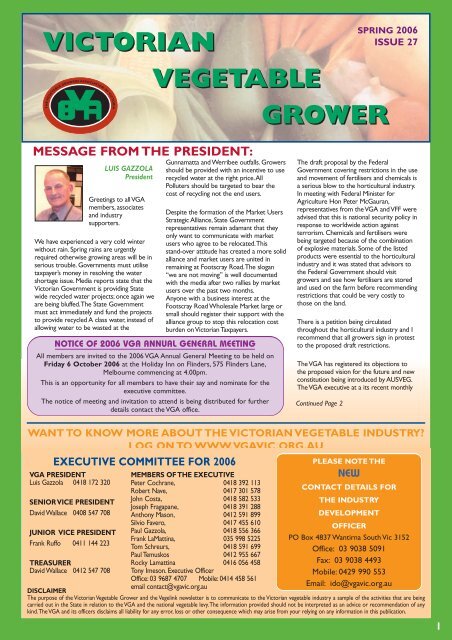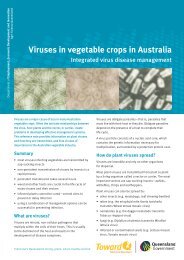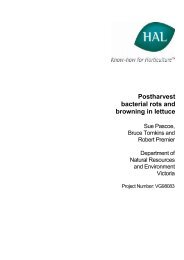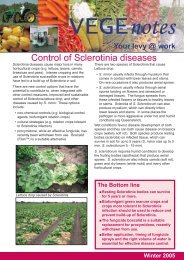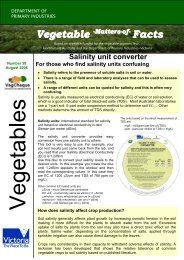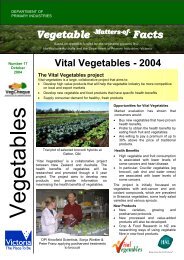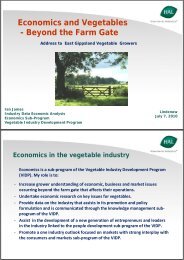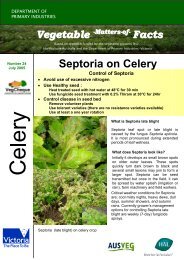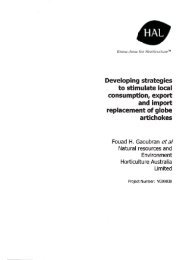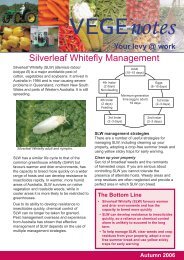No. 27 download pdf 845k - Vegetable Growers Association of Victoria
No. 27 download pdf 845k - Vegetable Growers Association of Victoria
No. 27 download pdf 845k - Vegetable Growers Association of Victoria
You also want an ePaper? Increase the reach of your titles
YUMPU automatically turns print PDFs into web optimized ePapers that Google loves.
VICTORIANVEGETABLESPRING 2006ISSUE <strong>27</strong>GROWERMESSAGE FROM THE PRESIDENT:LUIS GAZZOLAPresidentGreetings to all VGAmembers, associatesand industrysupporters.We have experienced a very cold winterwithout rain. Spring rains are urgentlyrequired otherwise growing areas will be inserious trouble. Governments must utilisetaxpayer’s money in resolving the watershortage issue. Media reports state that the<strong>Victoria</strong>n Government is providing Statewide recycled water projects; once again weare being bluffed.The State Governmentmust act immediately and fund the projectsto provide recycled A class water, instead <strong>of</strong>allowing water to be wasted at theGunnamatta and Werribee outfalls. <strong>Growers</strong>should be provided with an incentive to userecycled water at the right price.AllPolluters should be targeted to bear thecost <strong>of</strong> recycling not the end users.Despite the formation <strong>of</strong> the Market UsersStrategic Alliance, State Governmentrepresentatives remain adamant that theyonly want to communicate with marketusers who agree to be relocated.Thisstand-over attitude has created a more solidalliance and market users are united inremaining at Footscray Road.The slogan“we are not moving” is well documentedwith the media after two rallies by marketusers over the past two months.Anyone with a business interest at theFootscray Road Wholesale Market large orsmall should register their support with thealliance group to stop this relocation costburden on <strong>Victoria</strong>n Taxpayers.NOTICE OF 2006 VGA ANNUAL GENERAL MEETINGAll members are invited to the 2006 VGA Annual General Meeting to be held onFriday 6 October 2006 at the Holiday Inn on Flinders, 575 Flinders Lane,Melbourne commencing at 4.00pm.This is an opportunity for all members to have their say and nominate for theexecutive committee.The notice <strong>of</strong> meeting and invitation to attend is being distributed for furtherdetails contact the VGA <strong>of</strong>fice.The draft proposal by the FederalGovernment covering restrictions in the useand movement <strong>of</strong> fertilisers and chemicals isa serious blow to the horticultural industry.In meeting with Federal Minister forAgriculture Hon Peter McGauran,representatives from the VGA and VFF wereadvised that this is national security policy inresponse to worldwide action againstterrorism. Chemicals and fertilisers werebeing targeted because <strong>of</strong> the combination<strong>of</strong> explosive materials. Some <strong>of</strong> the listedproducts were essential to the horticulturalindustry and it was stated that advisors tothe Federal Government should visitgrowers and see how fertilisers are storedand used on the farm before recommendingrestrictions that could be very costly tothose on the land.There is a petition being circulatedthroughout the horticultural industry and Irecommend that all growers sign in protestto the proposed draft restrictions.The VGA has registered its objections tothe proposed vision for the future and newconstitution being introduced by AUSVEG.The VGA executive at a its recent monthlyContinued Page 2WANT TO KNOW MORE ABOUT THE VICTORIAN VEGETABLE INDUSTRY?LOG ON TO WWW.VGAVIC.ORG.AUEXECUTIVE COMMITTEE FOR 2006VGA PRESIDENTLuis Gazzola 0418 172 320SENIOR VICE PRESIDENTDavid Wallace 0408 547 708JUNIOR VICE PRESIDENTFrank Ruffo 0411 144 223TREASURERDavid Wallace 0412 547 708MEMBERS OF THE EXECUTIVEPeter Cochrane, 0418 392 113Robert Nave, 0417 301 578John Costa, 0418 582 533Joseph Fragapane, 0418 391 288Anthony Mason, 0412 591 899Silvio Favero, 0417 455 610Paul Gazzola, 0418 556 366Frank LaMattina, 035 998 5225Tom Schreurs, 0418 591 699Paul Temuskos 0412 955 667Rocky Lamattina 0416 056 458Tony Imeson. Executive OfficerOffice: 03 9687 4707 Mobile: 0414 458 561email contact@vgavic.org.auPLEASE NOTE THENEWCONTACT DETAILS FORTHE INDUSTRYDEVELOPMENTOFFICERPO Box 4837 Wantirna South Vic 3152Office: 03 9038 5091Fax: 03 9038 4493Mobile: 0429 990 553Email: ido@vgavic.org.auDISCLAIMERThe purpose <strong>of</strong> the <strong>Victoria</strong>n <strong>Vegetable</strong> Grower and the Vegelink newsletter is to communicate to the <strong>Victoria</strong>n vegetable industry a sample <strong>of</strong> the activities that are beingcarried out in the State in relation to the VGA and the national vegetable levy.The information provided should not be interpreted as an advice or recommendation <strong>of</strong> anykind.The VGA and its <strong>of</strong>ficers disclaims all liability for any error, loss or other consequence which may arise from your relying on any information in this publication.1
VICTORIAN VEGETABLE GROWERTony Imeson. Executive OfficerI had the opportunity to represent theVGA at the NZ HorticultureConference held in Auckland in earlyAugust. 700 delegates were inattendance together with an exhibition<strong>of</strong> 40 static displays covering industrysuppliers’ products and technologyequipment.The opening morning providedpresentations to all delegates looking atthe trends for the horticultural industryfrom a Government aspect, cateringindustry expectations and trends forpresent and future generations.Throughout the three days there wasan opportunity to attend concurrentbreakouts.These ranged from the Rolein Horticulture for the Food &EXECUTIVE OFFICER’S CORNER POSTBeverage Sector, Domestic Protectionfrom Imported Diseases,Water Threatsand Opportunities for Horticulture,Commercialising your Produce, EnergyFuelling Horticulture to 2020 to DirectSelling a Way <strong>of</strong> the Future.United Fresh NZ provided an excellent“5 a Day” presentation covering thedevelopment <strong>of</strong> the programme since1994.There had been success with earlychildhood centres, primary schools andthe achievements with consumerrecognition <strong>of</strong> a health fruit andvegetable daily intake.An interesting panel session featured onhow the news media viewed thehorticultural industry and it wasinteresting to note that the media werevery critical that statistics forhorticulture were out <strong>of</strong> date beforebeing published. Sounds familiar toAustralian statistics in horticulture!The final day allowed each commodityproduct group to address delegates.An engaging session was thepresentation by an Idaho USA potatogrower who is the current Chairman <strong>of</strong>United Potato <strong>Growers</strong> <strong>of</strong> America.Thisis a recently formed cooperative <strong>of</strong>potato growers to combat the impact<strong>of</strong> supermarket dominance <strong>of</strong> thepotato supply industry.This would haveappeared to be an old strategy toAustralian growers, however thiscooperative is working and providingrewarding results for growers.This was a very well organisedconference and full marks to Ron Gallthe conference coordinator.Renewals have been distributed for2006-2007 VGA membership togetherwith invitations to <strong>Victoria</strong>n vegetablegrowers not recorded in our currentmembership files.We invite any non-member on themailing list to consider providingsupport to the VGA in tackling industryissues by becoming a member.Membership application forms areavailable from the VGA <strong>of</strong>fice.Keep smilingTony ImesonVGA Executive OfficerMESSAGE FROM THE PRESIDENT:(continued from Page 1)meeting sent a strong message to the AUSVEG board andadministration that they suspend any further development <strong>of</strong> anew constitution and consider the outcomes from the <strong>Vegetable</strong>Industry Development Group before any further review andchanges to the AUSVEG structure and its current constitution.AUSVEG was formed for vegetable growers utilising vegetablegrowers levy money to provide research and developmentprojects for the benefit <strong>of</strong> the vegetable industry.This wouldappear not to be the viewpoint <strong>of</strong> the current AUSVEGadministration and obviously are not listening to you the levypayinggrower.This is a concern expressed by other State Organisations and theVGA Executive look to all <strong>Victoria</strong>n <strong>Vegetable</strong> <strong>Growers</strong> tosupport your association with membership ensuring that growersretain control over industry levy funding projects.There are many issues facing the vegetable industry and the next12 months will be a test <strong>of</strong> our strength and unity. May we havehealth and prosperity for the future? Wishing you all health andprosperity.Luis GazzolaPresidentVGA and Visy Board give award to productionhorticulture studentAt the July meeting <strong>of</strong> the 2007 National <strong>Vegetable</strong> ExpoCommittee, Luis Gazzola (president <strong>of</strong> VGA) presentedVicki Giacometti with the 2006 Werribee ProductionHorticulture Award for the best second year student andthe most improved student at the college.The VGA wouldlike to congratulate Vicki for her efforts in achieving thisaward.2
V i c t o r i a nYOUR LEVY AT WORKIssue <strong>27</strong>•SPRING2006BIG (GOOGLE) BROTHERAs I visited a farmer in central <strong>Victoria</strong>, he asked me if I had already <strong>download</strong>ed Google Earth from theInternet.When I answered that I had not seen that program yet, he enthusiastically showed me how it worked.He was able to show me a bird’s eye view <strong>of</strong> a number <strong>of</strong> places around the world, including the town inSouth America where I grew up.The picture was very clear. I could even see some cars and buses on the road.When I got back home from my visit, one <strong>of</strong> the first things I did was to <strong>download</strong> Google Earth to check if Icould see my house in Melbourne.Yes, it was there. I could even see the ro<strong>of</strong> <strong>of</strong> the garden shed in thebackyard.Apart from its entertainment value, it was clear to me that this technology could have important applicationsin agriculture. Surely, this technology should be able to easily replace at least some basic applications <strong>of</strong> aerialphotography.To test this idea, I decided tocheck if I could find some <strong>of</strong> the vegetablefarms that I have visited in the region. I wasable to instantly recognise the area includinghouses and buildings.Any one would be able todraw a fairly accurate farm map based on theimages available.It was easy to start thinking <strong>of</strong> the futureapplications <strong>of</strong> this technology. If we have thoseimages today, I wondered what type <strong>of</strong> pictureswe might be able to obtain in ten or twentyyears.Are we going to have images that indicatepest and disease problems? How about nutrientdeficiencies? Irrigation needs? Weed affectedareas? Even labour efficiency might be able tobe monitored one day with an improvedversion <strong>of</strong> this technology.And what if youwanted to check your competitors in Australiaand other countries? Would it be possible toGrower Propertycheck their level <strong>of</strong> production and theirpotential yields? Perhaps that can be done now, I am not sure.The problem is that if you are able to ‘look overthe fence’ using this technology, your competitors will also be able to see what you are doing. Large customersmight one day decide it is in their interest to monitor crops as they grow. Even government agencies mightdecide they want to know a bit more about farmers.Don’t take me wrong. I am not proposing a new conspiracy theory. I am only highlighting how technology isadvancing so rapidly that in some cases we do not have time to consider all the implications, good and bad.Our ability to quickly assess and adopt appropriate technologies is critical if we want to competeinternationally.We must be able to rapidly assess the potential impact <strong>of</strong>emerging technologies so we can select the better ones.The ability to reactquickly to the challenges and opportunities presented by technologies suchas the ones used by Google Earth will be an important factor in succeedingin an environment where change is happening at an accelerated rate.By Patrick UlloaEDITOR:PATRICK ULLOAIndustry Development OfficerPO Box 4837, Wantirna South VIC 3152Tel: 03 9038 5091 Fax: 03 9038 4493Mobile: 0429 990 553 Email: ido@vgavic.org.au3
The Accomodating SyndromeThere are a number <strong>of</strong> competing influences that help mould our behaviour. One set <strong>of</strong> forces that <strong>of</strong>ten clash is adesire to do our duty and the need to be liked and fit in.Youth <strong>of</strong>ten grow up in subcultures where succeeding issimply not fashionable.They quickly learn that achievement <strong>of</strong>ten brings envy and disdain. Stories abound <strong>of</strong> youngpeople who have buried their talents so as not to appear too successful, talented, or intelligent in the eyes <strong>of</strong> theirfriends.Sooner or later these individuals enter the workforce, where things are not much different. Individuals who areperceived as working too hard are <strong>of</strong>ten targeted for punishment by co-workers.When employees becomesupervisors, foremen or crew leaders these challenges are compounded.As supervisors, such individuals seek theapproval <strong>of</strong> subordinates rather than their own supervisor.Even though the boss might clearly explain why a task needs to be done a certain way, when it comes time to explainit to the workers, this supervisor is more likely to just blame the change on management. I like to call such behavioursthe accommodating syndrome.These supervisors want to be seen as one <strong>of</strong> the gang: to be liked by the subordinates.When a person decides to favour subordinates without regard to the situation, sooner rather than later he will hurtthe enterprise. Such is the case, for instance, when he looks the other way at poor quality work. Or, when his lack <strong>of</strong>loyalty is an example for all to follow.Supervisors who yield to the pressures <strong>of</strong> the accommodating syndrome may be surprised to find out that in the longrun they end up loosing the respect <strong>of</strong> both the boss as well as the employees they manage.<strong>No</strong>t for a moment am I suggesting that supervisors should only be concerned with the needs <strong>of</strong> the enterprisewithout regard to the employees. Such individuals are <strong>of</strong>ten autocratic and self-serving, prone to abuse <strong>of</strong> power andauthority.They are willing to climb the organizational ladder at the expense <strong>of</strong> those they step over. Sometimes theywork very fast to impress those in management, but then cannot sustain the pace they have set for themselves.Theirloyalty is to themselves. It is not surprising that supervisors who only look at their own needs, or those <strong>of</strong>management, are greatly detested by employees.Instead, what is needed is a supervisor who carefully seeks to understand the needs <strong>of</strong> both management andworkers. It is clear to such individuals that effective policies must benefit both the enterprise and the employees ifthey are to be sustainable.This supervisor is loyal to both the worker and the organization. He is kind but firm—andabove all, fair, honest, and full <strong>of</strong> integrity. Such a person is not afraid to take chances and help management oremployees understand the valid concerns the other may have.This foreman or crew leader does not take pleasure in the authority he has. Sometimes he will have to take flack fromemployees.With time subordinates will <strong>of</strong>ten come around and not only recognize that he acted fairly, but evendefend him even when he is not around. Certainly, it takes time and effort to become such a supervisor.The goodnews is that at least some supervisors are able to leave behind the ugliness <strong>of</strong> the accommodating syndrome. If youhave found such an individual among those who work for you, it is worth going out <strong>of</strong> the way to retain him.For more information on agricultural labour management log on tohttp://www.cnr.berkeley.edu/ucce50/ag-labor/Gregorio BillikopfUniversity <strong>of</strong> California(reprinted with permission) © 2006, University <strong>of</strong> California4
Aquaponics pioneers organise field day in <strong>Victoria</strong>Aquaponics is the word created by combining ‘aquaculture’ and ‘hydroponics’.Aquaponics is the farming <strong>of</strong> fish andplants together – so that fish wastes grow plants through organic hydroponics.A third component <strong>of</strong> this system isthe beneficial bacteria that transform the fish waste into suitable nutrients for the plants.Recently, a field day was organised to show the first commercial aquaponic site in <strong>Victoria</strong>.The field day wasorganised by Dr Wilson Lennard and Warren Watkins from Minnamurra Aquaponics. Dr Lennard is Australia’s firstPhD in aquaponics. Dr Lennard and Warren have partnered to establish an impressive small scale operation todemonstrate how aquaponics works commercially. Minnamurra Aquaponics is located in a small farm in KinglakeWest in the central highland foothills <strong>of</strong> <strong>Victoria</strong>.The production site is being used to grow Australian Murray codfish, and basil. Other vegetables are also being trialled. It isexpected that this site will be able to advance commercial,educational, and hobbyist aquaponics in Australia.Warren Watkins (left) and Dr Wilson Lennard inspect one <strong>of</strong>their aquaponics crops. Photo courtesy <strong>of</strong> www.urbanag.infoPeople that attended the field day were able to inspect theinsulated shed where fish are grown under controlledconditions. Nearby there is a hydroponics polyhouse whereplants are being tested for suitability. Pipes connect bothstructures to ensure water moves from the fish tanks to thebacterial filters, then to the polyhouse and back to the fishtanks.According to Ge<strong>of</strong>f Wilson, editor <strong>of</strong> AquaponicsNetwork Australia, Minnamurra Aquaponics is the simplestoperation he has enjoyed inspecting. He found that everythingnecessary was there, but is has been designed for mostefficient working and minimum chance <strong>of</strong> problems.According to Ge<strong>of</strong>f, Minnamurra Aquaponics is in sharpcontrast to the “spaghetti junction” appearance <strong>of</strong> many operations he has visited.Apart from the field day,The Aquaponics Network Australiaalso organised a series <strong>of</strong> lectures with a number <strong>of</strong>international experts, and has prepared a report includingthe information presented during that event.The report istitled ‘Aquaponics Investment in Australia’ and can bepurchased on line for $50, or $75 for a hard copy. Formore information, log on to www.urbanag.infoCertainly, aquaponics may have potential for growersattempting to use biological methods as the basis <strong>of</strong> theirhydroponic production, and also as an opportunity fordifferentiation. Later, a second field day is likely to beorganised for growers that were not able to attend thisevent.Also, a short DVD has been prepared highlightingsome basic aspects <strong>of</strong> aquaponics shown during the field day.Dr Lennard thinks that fish in tanks should be given enoughspace to move. Photo courtesy <strong>of</strong> www.urbanag.infoFor a copy <strong>of</strong> the DVD, contact the <strong>Victoria</strong>n <strong>Vegetable</strong> IndustryDevelopment Officer, Patrick Ulloa (0429 990 553);Email: ido@vgavic.org.au5
YOUR LEVY AT WORKThe R&D ShopThe order form bellow contains the new materials that have been added to the R&D Shop.You can use thisform to order these materials. Otherwise, log on to www.vgavic.org.auDVDsManuals andGuidlinesPostersProducts Contents QtyLettuce Aphid Field daySimply Green TomatoesAquaponics field dayGuide to Common Diseases andDisorders <strong>of</strong> ParsleyMajor diseases <strong>of</strong> parsleyCommon diseases <strong>of</strong> lettuceIt shows how Peter Schreurs & Sons hasimplemented IPM to control lettuce aphidPresentation given by Marilyn Lanyon telling the story <strong>of</strong>how she developed a successful value added productDr Wilson Lennard shows his combined fish andhydroponic operation (aquaponics)List a large number <strong>of</strong> diseases and disorders, showingsymptoms and suggesting control measures59x42 cm poster showing symptoms <strong>of</strong> majordiseases <strong>of</strong> parsley84x60 cm poster showing symptoms <strong>of</strong> lettucediseasesName _______________________________________________________________________Street Address_____________________________________________________________________Town_______________________________________Postcode __________________________________ Tel _____________________________________ Email _____________________________________Send to Patrick Ulloa, Industry Development Officer PO Box 4837 Wantirna South Vic 3152 Fax 03 9038 4493.Email: ido@vgavic.org.au<strong>Victoria</strong>n company goes naturalPatrick Ulloa, the <strong>Victoria</strong>n vegetable industry development <strong>of</strong>ficer (IDO), was invited by Michael Rogers from greenplanet tovisit the company’s green waste recycling and composting facility in Epping (<strong>No</strong>rth Melbourne).The facility receives green wastefrom a number <strong>of</strong> council depots and recycling centres.The facility also receives a by-product from the paper recycling industry.Only long fibres can be recycled into paper products.The short fibres used to be sent to landfill sites. <strong>No</strong>w, these short fibresare mixed with green waste as a source <strong>of</strong> carbon to improve the compost produced at the site.The compost produced by greenplanet undergoes a stringent qualitycontrolled composting process.The mulching machines designed by thecompany produce different sizes <strong>of</strong> green waste, which ensures an aerobic(enough oxygen available) composting process.The compost reaches over60ºC which kills the seeds and pathogens that were common in ‘councilmulch’ in the past.The Biological Farmers <strong>of</strong> Australia audits the processand the product is registered as organic farming input.The local IDO will be working with greenplanet to set up a trial with avegetable grower to assess the benefits <strong>of</strong> the greenplanet compostunder vegetable production conditions.For further information about greenplanet, log on towww.greenplanet.net.auComposted mulch after processing6
VICTORIAN VEGETABLE GROWER<strong>Vegetable</strong> production students receive new tractorfrom National Expo CommitteeStudents at the Gordon Institute <strong>of</strong> TAFE (Werribee South Campus) are now enjoying the chance to learn advanced practicalskills thanks to a new tractor and disc cultivator made available by the National <strong>Vegetable</strong> EXPO Committee – Werribee.Thecommittee is keen to support the education <strong>of</strong> young people in the industry, and this contribution will help many studentslearn those skills that are in demand in the industry. Other organisations that assisted in making this contribution possible areNew Holland, R.P. Motors Werribee South, and John Berinds & Son.David Milburn, one <strong>of</strong> the teaching coordinators in Werribee, explained that this type <strong>of</strong> equipment allows student to receivepractical lessons that are vital for their pr<strong>of</strong>essional development. Students attending the college in Werribee are fortunate tohave a program which includes this type <strong>of</strong> work under teacher supervision. Many other students have to go throughprograms where on the job training is the main teaching method.That can sometimes be less than ideal for students. Davidexplained that in those cases where vegetable growers are very pr<strong>of</strong>essional and have a strong commitment to studentdevelopment, on the job training can be rewarding, but unfortunately, not all growers have that type <strong>of</strong> commitment. Manystudents are given only minor tasks to perform with little opportunities to come in contact with more advanced technology.In the worse cases, students are only employed as cheap labour.This wrong attitude towards student development is only a symptom <strong>of</strong> a more serious image problem that affects thevegetable industry in general.While a number <strong>of</strong> progressive industry people are adopting an ever increasing level <strong>of</strong> advancedtechnology, others still see vegetable production as a backward activity.With that type <strong>of</strong> image, no wonder there are very fewyoung people that are willing to spend time and effort studying vegetable production. Given the choice, most young peopleinterested in agriculture careers choose amenity horticulture (landscaping, nursery, turf) which has a much better image.In reality, the vegetable industry can provide great career prospectsfor young people. Seed and fertiliser companies have top jobsavailable for people with practical industry experience. Largervegetable businesses are likely to need better qualified people formiddle management positions. Good training programs as the onedelivered in Werribee need to be enhanced, and more needs to bedone by the vegetable industry to project a more positive imagethat takes into account the advanced technology currently beingadopted by many growers.The contribution <strong>of</strong> the National<strong>Vegetable</strong> EXPO Committee is a good step in that direction.David Milburn shows the new tractor made availableby the EXPO committeeProperly guarded farm equipment works…insist on itWorkSafe <strong>Victoria</strong> has urged farmers to ensure equipment they’re considering buying has appropriate safety equipment.“Whether it’s power-take-<strong>of</strong>f guards, seatbelts or rollover protection, safety equipment is not an optional extra,”WorkSafe <strong>Victoria</strong>’s Executive Director, John Merritt, said.“Machinery dealers should be supplying equipment as part <strong>of</strong>the sales package.”A Sydney pump manufacturer was convicted and fined $18,500 in the Bendigo MagistratesCourt in May after pleading guilty to one charge laid under the Occupational Health and SafetyAct arising from the death <strong>of</strong> a farm worker at Lake Boga in 2003.The man died when hebecame caught in a partially-unguarded universal joint. <strong>No</strong> guard was supplied with the pumpwhich was attached to a tractor.The man’s employer was fined $20,000 in January 2005.7


